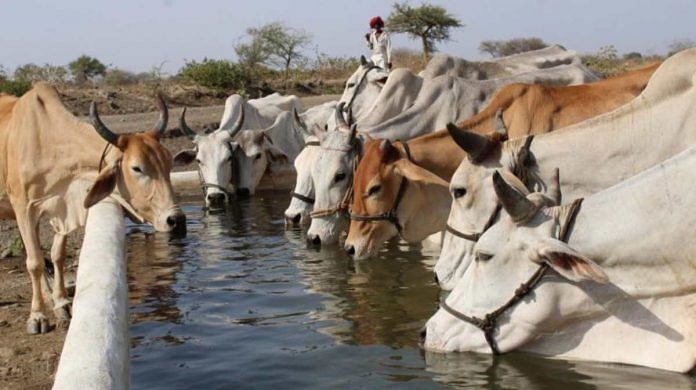New Delhi: A BJP MP-led parliamentary standing committee has slammed the Animal Husbandry department for a substantial dip in funding of schemes aimed at promoting the health and preventing diseases in livestock such as cows, buffaloes, sheep, goats and camels, among others.
In a report tabled in the monsoon session of Parliament, the standing committee on agriculture, led by the Karnataka BJP MP P.C. Gaddigoudar, said there is a widening gap between the amount initially allocated in budgets and the final grant to some of the schemes.
It particularly singled out the Livestock Health and Disease Control (LHDC) scheme, which was first launched in 2010 to track “animal diseases of economic importance” such as foot-and-mouth disease (FMD) in cows and other cloven-hoofed animals.
According to the report, not only had funding for the scheme plunged between 2017-18 and 2021-22, some of its subcomponents did not receive a single penny in the last fiscal.
Take the National Animal Disease Reporting System (NADRS), a crucial subcomponent of the LHDC scheme.
The NADRS was first unveiled in 2009 to track livestock diseases, and contain outbreaks. When the Modi government took over in 2014, it upgraded the scheme to NADRS 2.0, taking it online to enable real-time reporting of animal diseases that would allow for quick action.
In 2019, the government even launched an NADRS 2.0 app, which was to also collect details of stray cattle.
But the Parliamentary panel report said that from Rs 6.79 crore in the 2019-20 fiscal, the fund allocation for NADRS 2.0 had plunged to zero in 2020-21.
The report said the animal husbandry defended itself by showing that in totality, funds allocated for the LHDC scheme were 100 per cent utilised.
The panel, however, found this misleading as, according to it, some of the LHDC subcomponents showed zero financial progress and physical achievements.
Also read: Liberal palm oil import rules will harm self-sufficiency, say farmers & traders, seek review
Poor veterinary infrastructure
In the report titled Status of veterinary services and availability of animal vaccines in the country, the parliamentary panel also expressed “utter dismay” that no veterinary hospitals or dispensaries were strengthened or established under LHDC between 2017-18 and 2020-21.
According to the report, states such as Arunachal Pradesh, Kerala and Jammu and Kashmir saw a reduction in veterinary hospitals from 2019-20 to 2020-21, while Himachal Pradesh, Maharashtra and MP saw a fall in the number of dispensaries in 2020-21 as compared to the previous fiscal year.
The report also found that Delhi and Chandigarh do not possess a single veterinary aid centre or mobile veterinary unit to cater to the needs of livestock owners.
According to the report, the Department of Animal Husbandry argued that this dip in veterinary infrastructure is because of the fact that a few states have revised the number of veterinary institutions based on their types and nomenclature.
The committee, however, still expressed dissatisfaction over the present status of inadequate veterinary infrastructure in the country.
‘Not enough veterinary staff and vaccines’
The Parliamentary committee also pointed out the poor availability of veterinary staff and animal vaccines, apart from the infrastructure.
It noted that current seats and veterinary colleges in the country are grossly inadequate to handle the increasing livestock populations. The panel has recommended increasing the number of seats in existing colleges with recognition of more veterinary colleges in the country.
According to the report, with a current livestock population of 535.78 million, the country requires 1,07,156 veterinary institutions against present strength of 65,894.
As for animal vaccination, the committee was informed that there is a requirement of about 982 million doses of foot-and-mouth disease vaccine, 41.4 million doses of Brucella vaccine, and 223.14 million doses of Peste des Petits Ruminants among others.
The panel has called for total self-dependence in manufacturing animal vaccines to meet the shortfall.
To overcome hurdles in vaccine coverage, the standing committee has recommended deployment of Krishi Mitra, and MGNREGA workers with the involvement of Panchayati raj institutions. This is to be taken up on lines similar to that of Mission Indradhanush, which is designed for vaccinating children.
(Edited by Arun Prashanth)
Also read: Forget petrol & diesel, prices of edible oils have soared even higher in June, July



